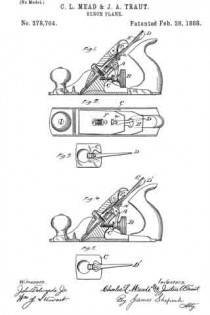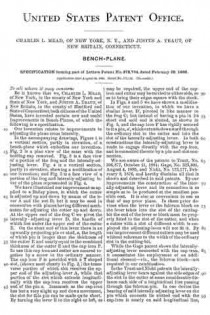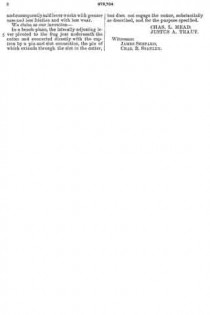
| PLEASE NOTE: The images presented on this page are of low resolution and, as a result, will not print out very well. If you wish to have higher resolution files then you may purchase them for only $2.95 per patent by using the "Buy Now" button below. All purchases are via PayPal. These files have all been cleaned up and digitally enhanced and are therefore suitable for printing, publication or framing. Each zip package contains all the images below (some packages may contain more), and purchased files can be downloaded immediately. |
UNITED STATES PATENT OFFICE.
_________________
CHARLES L. MEAD, OF NEW YORK, N. Y., AND JUSTUS A. TRAUT,
OF NEW BRITAIN, CONNECTICUT.
BENCH-PLANE.
_________________
SPECIFICATION forming part of Letters Patent No. 378,704, dated February 28, 1888.
Application filed August 24, 1885. Serial No. 175,142. (No model.)
_________________
To all whom it may concern:
Be it known that we, CHARLES L. MEAD, of New York, in the county of New York and State of New York, and JUSTUS A. TRAUT, of New Britain, in the county of Hartford and State of Connecticut, both citizens of the United States, have invented certain new and useful Improvements in Bench-Planes, of which the following is a specification.
Our invention relates to improvements in adjusting the plane-irons laterally.
In the accompanying drawings, Figure 1 is a vertical section, partly in elevation, of a bench-plane which embodies our invention. Fig. 2 is a plan view of the same with the holding-cap removed. Fig. 3 is a face view of a portion of the frog and the laterally-adjusting lever. Fig. 4 is a vertical section, partly in elevation, showing a modification of our invention; and Fig. 5 is a face view of a portion of the frog and laterally-adjusting lever of the plane represented in Fig. 4.
We have illustrated our improvement as applied to a Bailey plane, in which the cutter is adjusted up and down by means of the lever A and the nut B; but it may be used in connection with planes having different mechanism for adjusting the cutter up and down. At the upper end of the frog C we pivot the laterally-adjusting lever D, the handle of which lies under the upper end of the cutter E. On the short end of this lever there is an upwardly-projecting pin or stud, a, the length of which pin is longer than the thickness of the cutter E and nearly equal to the combined thickness of the cutter E and the cap-iron F. In use this cap-iron and cutter are secured together by a screw in the ordinary manner. The cap-iron F is provided with a T shaped slot, (shown most clearly in Fig. 2,) the transverse portion of which slot receives the upper end of the adjusting-lever A, while that portion of the slot which extends longitudinally with the cap-iron receives the upper end of the pin a. Inasmuch as the cap-iron has but a very slight up and down movement, the slot for this pin can be made quite short. By turning the lever B to the right or left, as may be required, the upper end of the cap-iron and cutter may be carried to either side, so as to bring their edges square with the stock.
In Figs. 4 and 5 we have shown a modification of our invention, in which we have a similar lever, D’, pivoted in like manner to the frog C; but instead of having a pin in its short end said end is slotted, as shown in Fig. 5, and the cap-iron F has rigidly secured to it a pin, a’, which extends downward through the ordinary slot in the cutter and into the slot of the laterally-adjusting lever. In both constructions the laterally-adjusting lever is made to engage directly with the cap-iron, and is connected thereto by a pin-and-slot connection.
We are aware of the patents to Traut, No. 306,877, October 21, 1885; Gage, No. 323,804, August 4, 1885, and Nicht, No. 173,177 , February 8, 1876, and hereby disclaim all that is shown and described in said patents. By our improvements the construction of the laterally-adjusting lever and its connection is so simple as to be produced at the smallest possible cost. It is also as convenient to use as that of any prior plane. In these prior devices when the lever or the fulcrum block on the lever takes into the slot of the cutting-bit the end of the lever or block must be properly fitted to the slot of the cutter, and when a cutter with a slot of different width is employed the adjusting-lever will not fit it. By our improvement different cutters may be used without reference to the width of the ordinary slot in the cutting-bit.
While the Gage patent shows the laterally-adjusting lever connected with the cap-iron, it necessitates the employment of an additional element — viz., the fulcrum block — not required in our combination.
In the Traut and Nicht patents the laterally-adjusting lever bears against the side edges of the slot in the cutter at some considerable distance each side of a longitudinal line passing through the fulcrum-pin. In our device the bearing of said laterally-adjusting lever on the pin which connects its slotted end with the cap-iron is nearly on said longitudinal line, and consequently said lever works with greater ease and less friction and with less wear.
We claim as our invention —
In at bench-plane, the laterally-adjusting lever pivoted to the frog just underneath the cutter and connected directly with the cap-iron by a pin-and-slot connection, the pin of which extends through the slot in the cutter, but does not engage the cutter, substantially as described, and for the purpose specified.
CHAS L. MEAD.
JUSTUS A. TRAUT.
Witnesses:
JAMES SHEPARD,
CHAS B. STANLEY.



